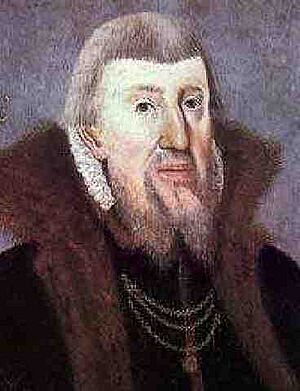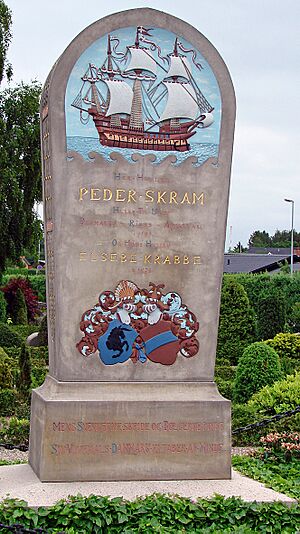Peder Skram facts for kids
Quick facts for kids
Peder Skram
|
|
|---|---|

Portrait of Peder Skram by unknown artist
|
|
| Nickname(s) | Denmark's Dare-devil |
| Born | Between 1491 and 1503 Horsens, Denmark |
| Died | 11 July 1581 (aged 78-90) Horsens, Denmark |
| Allegiance | |
| Service/ |
|
| Years of service | 1518–1562 |
| Rank | Admiral |
Peder Skram (died July 11, 1581) was a brave Danish admiral. He was known as a great naval hero. People even called him "Denmark's Dare-devil" because of his courage at sea.
Contents
Peder Skram was born in Denmark, sometime between 1491 and 1503. His family lived on an estate called Urup, near a town named Horsens in Jutland.
Early Adventures and Military Service
Peder Skram started his military career quite young. He served King Christian II during a big war called the Swedish War of Liberation. This war was about Sweden trying to become independent from Denmark.
First Battles and Rewards
In 1518, Peder Skram fought in his first battle, the Battle of Brännkyrka. He also helped save a Danish nobleman, Mogens Gyldenstierne, during the Conquest of Uppsala in 1521. Because of his brave actions, the King gave him an estate. Peder settled there for a while with his wife, Elsebe Krabbe.
The Count's Feud: A Time of Civil War
Later, Denmark faced a civil war known as the Count's Feud. This was a fight over who should be the next king. Peder Skram was sent to help Gustavus Vasa, the King of Sweden. Gustavus was an ally of Christian III, who eventually became the new Danish king.
Fighting the Hanseatic League
Peder Skram worked with the Swedish admiral, Mans Some, to organize the Swedish navy. Their main job was to stop the Hanseatic League, a powerful group of trading cities, who were supporting the other side.
Skram was very successful. He captured a whole fleet of ships from the Hanseatic League near a town called Svendborg. He also stopped them from attacking Copenhagen, the capital city. Even though the Swedish King Gustavus was a bit suspicious, Peder Skram's efforts helped the allied forces a lot.
Rewards and New Roles
After the war, King Christian III rewarded Peder Skram for his great service. The King made him a knight and gave him a place on the Council of State. This was a very important group of advisors to the King. He also received more land and estates.
The Northern Seven Years' War
By 1555, Peder Skram felt he was too old to go to sea and resigned from his admiral position. But seven years later, in 1562, another big war started. This was the Northern Seven Years' War. The new king, Frederick II, asked Skram to lead the navy again.
Return to the Sea
Even though he was older, Peder Skram agreed to help. He took command of a large fleet in August 1562. He fought against the Swedish admiral near the coast of Gotland and forced the Swedish ships to hide. However, this was his only major action in this war. By the end of the year, another admiral, Herluf Trolle, took over his command.
Retirement and Final Years
After this, Peder Skram fully retired from active service. He went to live on his estate at Laholm in Halland. The Swedes tried to attack his estate twice between 1565 and 1568, but they failed.
Peder Skram passed away at his Urup estate on July 11, 1581. He is buried at Østbirk Church, which was once part of his family's Urup estate near Horsens.


